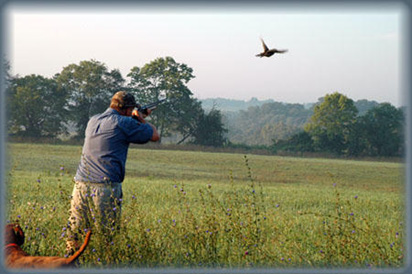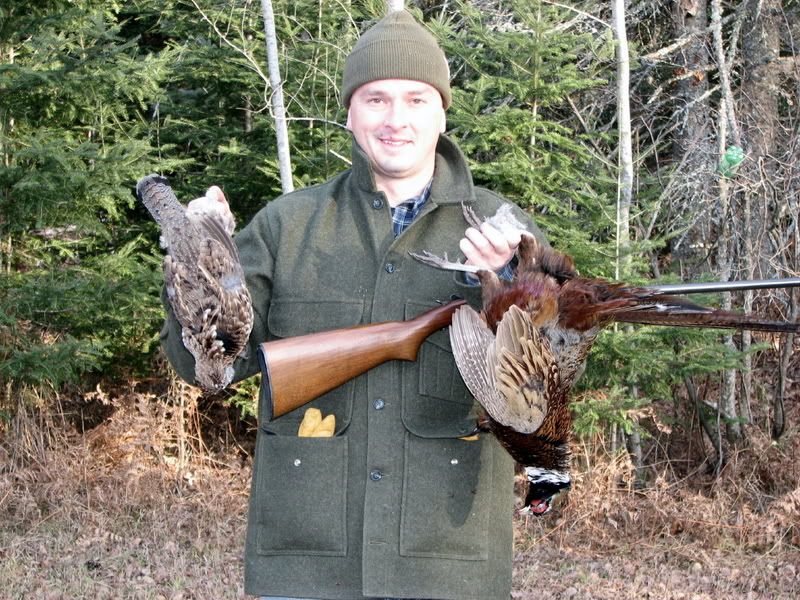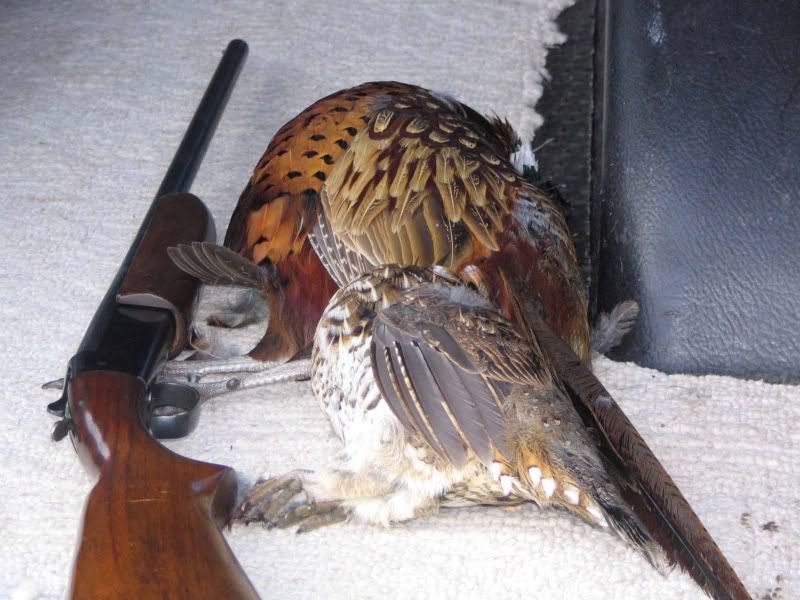

 The Accurate Reloading Forums
The Accurate Reloading Forums  THE ACCURATE RELOADING.COM FORUMS
THE ACCURATE RELOADING.COM FORUMS  Hunting
Hunting  Bird Shooting
Bird Shooting  410--Skeet or Full Choke
410--Skeet or Full ChokeGo  | New  | Find  | Notify  | Tools  | Reply  |  |
one of us |
If you had a model 42 Winchester for hunting grouse, some game farm pheasants, and the occassional wild pheasant, which choke would you choose if your choices were either skeet or full? Will the skeet choke break up too fast to be effective beyond 30 yards? Most grouse shots are closer so this doesn't seem to be as much of an issue with a skeet choke, same with game farm birds. But wild pheasants a full will probably be better. Your thoughts would be greatly appreciated. | ||
|
| one of us |
You are going to have to pattern your gun to draw any type of conclusion. There just isn't enough pellet count to properly populate a pattern to make a .410 much more than a 25-30 yard pheasant gun, regardless of choke. | |||
|
one of us |
Let's skip the patterning for now, I need an answer! One choke, skeet or full? | |||
|
| One of Us |
Ok I'll play, a 16 gauge choked for the distances you encounter the most shots at. The .410's best pattern comes with shot 7.5 or smaller, which have no business being used on a pheasant past 25 yards, so skeet would work, provided you avoid going away shots on pheasant no more than 25 yards from you. For quail I'd say an IC or mod would be good to the limit of the small .410 payload's effectiveness of 30-35 yards. The .410 can kill pheasants, it simply is no where near ideal-especially for wild ones. Shots over a good pointing dog are best. | |||
|
one of us |
Planemech, So given what you have said, which would you choose, skeet or full? 3" of 8 shot, is the pattern going to be that much different at 30 yards with a full vs a skeet? | |||
|
| One of Us |
Full choke, man! it's a .410. Kill the bird or miss cleanly. Skeet choke and the .410 can be dicey on birds, and even preserve birds deserve some respect as prey. | |||
|
| One of Us |
full choke with a 410,,, miss or kill cleanly,,, in guiding bird hunters in TEXAS a man with a 410 is to be feared,,,, he eatheris very good, or listened to his friends and spent his money unwisely | |||
|
| one of us |
A .410 is a poor choice for pheasants, period. Choke won't help when there is inadequate payload to begin with. It is a horrible crippler, and was never designed to be a field gun in the first place-- it is a "taxidermist's gun." | |||
|
| One of Us |
With a skeet/skeet choked 20 ga. O/U I have had excellent results on the type game you describe. That said... With a .410 I would not even consider the skeet choke. Go full if you want to hunt with a .410. Respect your prey man. Cheers, Don | |||
|
| One of Us |
The idea that with a full you miss clean or kill is a falacy, aa bit if time at the pattern board will show you this very quickly. In .410 the best payload you can get is 11/16ths ounce, it's not enough for any pellet size larger than 7, and since #7 is not commerically loaded in .410 that means #7.5. Now 11/16ths ounce is a viable load in 7.5 for pattern density adequate for pheasants, the shot size however isn't past 25 yards- it simply does not posses the retained energy to ensure adequate penetration from all angles. Additonally the 3" .410 shot column is very long and as such has a higher percentage of damaged pellets in it from setback and barrel scrub than the 3/4oz 28 for example. Pattern performance and size is standard for all the gauges. The standard for performance is 70% of the payload in a 30 inch circle at distance. 20 yards for cylinder, 25 yards for skeet, 30 for improved cylinder, 32.5 for skeet 2, 35 for modified, 37.5 for improved modified and 40 yards for full. The problem with choke is the tighter the choke the slower the opening of the patern to it's design range and the faster it degrades after that. The .410 damages more shot in the process of firing than as a percentage of the total than any other shotshell, and it has the fewest to spare in the first place. Again some time at the pattern board will show you this quickly. Chukar and quail do not take much killing and 8 or 7.5 is a fine choice for them-especially on preserves. Pheasants run upwards of 3 lbs vs. 6-8oz for a quail or 1 lb for a chukar the shot energy requirements are wildly different. Preserve pheasants are ofetn encountered closer than wild, though it isn't an ironclad rule. For pheasants well pointed and held close by a dog the .410 can be an effective gun, if the pheasants do not play along it's a disaster waiting to happen. With the .410 more damaged shot is leaving the pattern rapidly than with any other gauge. Full choke further degrades the performance as it allows very litle "aiming error" with it's very tight patterns at close range where the 7.5 shot is a viable choice for pheasant. A pheasant can carry a bunch of shot in the breast, back and legs that render lesser sized birds incapacitated, it doesn't mean they won't die later often they will it's just you'll never recover it. So I recommend a larger bore, if you must shoot them with a .410 since 25 yards is all the shot size is good for I recommend the optimum pattern for that range- skeet and a very judicious choice of shots. A far better choice where pheasants are concerned is a bore that will handle 1 ounce of #6 and it's choked for the ranges you are encountering the shots at. I hunt pheasants from season opener to close and when they are the goal I always carry a 16 with at least 1 ounce of #6 and chokes appropriate for the range I'll be using it at. I do not hesitate to shoot them while quail hunting with a 28 provided they are in a range appropriate to the load in the chamber. | |||
|
| One of Us |
Planemech, well said. The .410 is not a pheasant gun under anything but unusual conditions. The pattern is considerably smaller even comparing skeet chokes from different gauges, at least my skeet Kolar tubes show that from 20 to .410. Contrary to what Randy said, the .410 is an effective gun hunting but it has to be tailored to a specific situations such as quail over dogs. I would not use one on chukar as they are just as likely to flush wild 25 yards from you, resulting in shots from 35 and up and that is not .410 range. The .410 also requires very precise leads and a lot of practice to get proficient. If you want to learn to shoot and shoot it well get the skeet choke and live with the limitations, which do not include pheasants as even pen raised birds will run on you and flush wild. | |||
|
| One of Us |
It is important to note that .410's often show much more choke per designation than do other gauges, in other words the manufacturers make them tighter than the nominal designation would lead one to believe. It is often the case with all smallbores. Apparently some feel the need to tighten up with a small bore rather than use a shot size appropriate to the bore. People make the mistake of judging a shotgun's "power" by it's bore dameter rather than the largest size shot that bore can use effectively pattern density wise. A 12 bore 3/4 oz load is not more "powerful" than a 28's given the same choke, shot size and launch speed. Now a 12 will handle shot sizes larger than a 28 will pattern well and it's larger payload ability allows dense patterns of that larger shot. This is what allows greater range and killing ability on larger birds. Time at the pattern board with a shotgun is just like time at the range with a rifle, one has to know what the paylod is doing and powder, primer and wad changes have the same effects on pattern that they do on bullets in metallic loading. Patterning is VERY important in reality instead it has a boring pointless rep. Would peop;e be happy with a rifle that threw it's bullet left or right high or low all the time? It's even more important with double barreled shotguns- just like double rifles. | |||
|
| One of Us |
Prewar 70: This 76 year old was delighted to read that a Win. 42 is still around and in action! ( It was my first shotgun). I happen to agree with practically everybody. If you are bounden determined to use a 410 on pheasants, then at least make sure it's full choke. I agree with people who say the 410 isn't a pheasant gun to begin with. I was in upstate NY back in the days when pheasant and ruffed grouse were our staple game birds. Frankly,even at 14, I never thought about using a 410 on pheasants -so I didn't try. I was not yet a ruff hunter and I shot at native quail with a 410 (without any particular success) (Yeah, in those days we had quail in NY) I hate to drag the discussion down - but I used my 410 principally in shooting rats on the town dump. I saw a teenager run off a straight 25 at 16 yard trap with a 410 just a few years ago so I appreciate that the 410 is a true shotgun - it's just that I (and my peers at the time) never thought of it as a game shotgun. I really think it goes just "a bridge too far". (beyond the 28 ga.) | |||
|
| One of Us |
Pre-War70....If you are hunting over dogs that point, I would use the #-6 shot with Full choke. Now if no dogs at your side, go with the full choke out passed 25 yards on pheasants, using #4-shot. Grouse hunting go with the FULL CHOKE #5 or #6 shot. Now a .410 is a mighty poor choice for pheasant or grouse in the woods. Your better off with a 16 gauge or a 12 gauge #4's with a imp/mod choke over pointing dogs or a Mod/Full if using flushing dogs. Regards....TONK | |||
|
| new member |
This is my first post here and I guess it's going to be a dandy. Unlike most of the people responding, I shoot a .410 on everything but waterfowl. In my opinion, you should shoot a full choke but understand that the really close birds will be difficult. Mainly I shoot dove and pheasant and have found there is only one load that works well: 1/2 oz. of HARD #9s driven around 1200+ fps. If you use larger shot, you won't have a decent pattern and cannot kill birds consistantly. Everyone knows that more shot in the air means a better chance of killing a bird so all are correct when they say bigger is better. With that in mind, I wonder how many shoot a 10 guage on upland birds? Not many. If I had my way everyone would shoot small guage shotguns on upland birds. We would have better hunters and fewer lost birds due to those one in a lifetime shots. Again, large shot in a .410 is a mistake. Shoot #9s in a target load that patterns and you can kill birds to 40 yards effectively. Now fellas, have at me. Harry | |||
|
one of us |
Here are a couple pictures from up north, near Duluth. I used my wife's grandpa's Winchester model 37, 26" barrel, full choke. I only had # 6s but fully argee with you Holson, that as much lead as one can get in the air the better, so nothing larger than 7.5s. I couldn't believe how sparse the pattern was at 20 yards with 6 shot. Grandpa's gun never saw a lot of action and it sure was fun to use it. The grouse and pheasy tasted mighty good for dinner that night. Great way to kick off deer season. Please excuse the first picture, apparently I was attempting my best just out of prison look.   | |||
|
| One of Us |
| |||
|
| new member |
Prewar70: Here are a few others taken with my .410. It is a kick in the butt to hunt these birds with a sub gauge gun when most will laugh at you or call you a liar when they hear what you're shooting. The first time I shot a .410 on pheasants was when I forgot my own shotgun on opening day 20 years ago and had to borrow something. That something was a .410 and I had a great day! Keep it up. Others may shoot more birds but few will have as much fun (or have nearly the bragging rights over drinks that night). http://onfinite.com/libraries/1059914/ea9.jpg | |||
|
| One of Us |
I've been hunting pheasants and grouse for 45 years or so, and I've seen pheasants absorb quite a bit of shot and put a lot of distance between them and the hunter. I saw a ringneck shot broadside at about 30 yards with 1 oz of #6 from a 16 ga (irrelevent), fold up in the air, fall into a plowed field, get up and shake and begin to run. If not for the dedicated retrieving and tracking skills of a German Wirehaired Pointer he would have made it to a nice, quiet place to die. I've shot pheasants with both a 28 ga and a .410 on preserves but I don't think there's any place for a .410 when hunting wild pheasants. To me, crippling a noble bird is not ethical hunting...Tom | |||
|
| new member |
tpdtom: Then i guess you should kill them instead of crippling them eh. | |||
|
| new member |
i love my .410, i've used it on everything (trap 16yds., grouse, pheasant, quail cottontail rabbit and snowshoe hare). I've found out the hard way 2 1/2" shells are useless, unless skeet shooting and don't ever use shot larger than #6, not near enough pellets. The only way to go is full choke!!!!! I've shot a lot of critters and there is nothing wrong with the .410 at modest distances. | |||
|
| One of Us |
I would not shoot grouse or pheasant with a four-ten but if I was determined to do so I would opt for the pattern density of a full choke. That is assuming you get uniform patterns of a sufficientlt effective load in that particular gun. Many do not. A four-ten is always marginal for birds and I only consider it adequate under optimal conditions.   ------------------------------------ I admit there are advantages in game of every type; But I've never heard of beast or bird to excel the twisting snipe. Nicholas Kane, Louisiana, 1880 Got Snipe? | |||
|
| Powered by Social Strata |
| Please Wait. Your request is being processed... |
|
 The Accurate Reloading Forums
The Accurate Reloading Forums  THE ACCURATE RELOADING.COM FORUMS
THE ACCURATE RELOADING.COM FORUMS  Hunting
Hunting  Bird Shooting
Bird Shooting  410--Skeet or Full Choke
410--Skeet or Full Choke

Visit our on-line store for AR Memorabilia

